 Purdue University - Extension - Forestry and Natural Resources
Purdue University - Extension - Forestry and Natural Resources
Got Nature? Blog
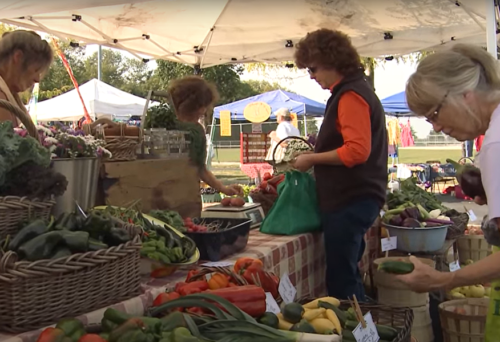 Purdue Extension Showcase, Purdue Extension Annual Report highlights Purdue Extension-Enhancing the Value of Public Spaces program: In Indiana, community leaders make decisions about public spaces such as parks, trails, and schools every day – decisions that affect the health and wellness of communities.
Purdue Extension Showcase, Purdue Extension Annual Report highlights Purdue Extension-Enhancing the Value of Public Spaces program: In Indiana, community leaders make decisions about public spaces such as parks, trails, and schools every day – decisions that affect the health and wellness of communities.
Purdue Extension’s Enhancing the Value of Public Spaces: Creating Healthy Communities program coaches communities through development of high quality action plans for public spaces, guiding decisions and better positioning communities to take advantage of opportunities to promote healthy eating and active living. The curriculum is designed for decision-makers and local leaders who have oversight and management of community public spaces, such as parks boards and plan commissions, public officials and their staff, and members of organizations whose missions relate to services, programs, or management of public spaces.
The program combines data collection and analysis with inclusive public deliberation to design action plans toward meaningful, sustainable improvements of public spaces focused on community health. The goal is to strategically guide policy, systems, and environmental changes to promote healthy communities.
Focusing on Blackford County, a series of online and in-person public participation workshops were conducted to gather residents’ input for the parks and recreation five-year master plan. Three visioning workshops – each two hours long – allowed community members to share assets and opportunities for placemaking, active living, and healthy eating. Podcasts and videos were provided, helping residents understand the conceptual framework. At the first visioning session, participants compiled assets and opportunities, and then voted on themes they felt needed to be the focus of the next two workshops. During the second visioning virtual session, participants focused on placemaking, active living, and healthy eating. In the third session, participants prioritized strategies. At the final session, also two hours, participants completed an action plan for each strategy for placemaking, active living, and healthy eating. In addition, a public survey was conducted to gather input from community residents who could not attend the sessions. Survey results, community data, and the action plan were presented to the community in a 62-page report.
There were 46 virtual participant surveys and 279 public surveys received. Demographics of survey respondents (n=182) were: 94% White, 69% female, and 44% age 25-44. A third (34%) reported they earned less than $50,000 annually, and 25% had attended some college but did not earn a degree. A post-program evaluation was completed by 26 participants (57%). Over 95% found the program informative, felt engaged in activities, and had meaningful discussions. Participants indicated significant takeaways were the concept of community capital, involvement is key, and the realization that there are resources and organizations in the county that can be partners for healthy living. Several mentioned takeaways were working together, communication, and that the program was a catalyst for progress.
Action strategies developed have seen progress since the plan was delivered. To expand and market community events in the parks and create outdoor movie nights downtown, Purdue Extension partnered with Taylor University Social Work Department, Hartford City, Firefly Children and Family Alliance, and Meridian Services to host a community movie night with a mental health awareness theme. More than 70 people attended. Resources, including a newly published community directory, were shared. To develop youth leadership opportunities for parks and public spaces, local students were asked what they would like to see in the community. Twelve high school students identified improvements to a basketball court, and asked for support from Purdue Extension to connect them with local funders. Students raised $1,700 through a Change War competition at school, and a pitch to the plant manager and human resource director at the local 3M factory resulted in an additional $1,600; new goals will be installed. As a result of this effort, a Mayor’s Youth Council will be started to focus on project-based efforts. Purdue Extension’s Enhancing the Value of Public Spaces: Creating Healthy Communities helped communities prepare public spaces action plans to boost economic development, improve the quality of life, and create a healthier place for individuals and families.
To read full article and others, check out Purdue Extension Showcase 2023.
Resources:
Community Development, Purdue Extension
Enhancing the Value of Public Spaces Program Video, Purdue Extension
Enhancing the Value of Public Spaces: Creating Healthy Communities, The Education Store – Purdue Extension’s resource center
Enhancing the Value of Public Spaces Curriculum, The Education Store
Sustainable Communities Extension Program Website, Purdue Extension
Conservation Through Community Leadership, The Education Store
Rainscaping Education Program, Purdue Extension
Subscribe to Purdue Extension – Forestry and Natural Resources YouTube Channel
Kara Salazar, Sustainable Communities Extension Specialist
Purdue University Department of Forestry and Natural Resources
Purdue Landscape Report: When I was a kid, if you’d asked me what my favorite season was it would always immediately be summer. No school, time for playing outdoors, swimming, hiking, and late nights playing flashlight tag. Now, if I ranked the seasons from worst to best, they’d be Summer in last, followed by Winter (yes, I choose winter over summer), and a tie between Spring and Fall. With the best temperatures, a mix of sun and rain/snow, and an explosion of colors from new blooms in the spring to the reds, yellows, and oranges of leaves before they drop in the fall, Spring and Fall are by far my favorite times of the year. Well, we are nearly to the autumnal equinox with temperatures beginning to drop and the onset of some fall showers as I write this article. With Fall on the doorstep, I’ve received a repeated question recently, “Is it ok to plant a tree in the Fall?”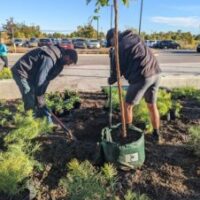
The short answer to this question is, “Yes!” If you want to add some new tree canopy to your yard, then pick your spot, choose the appropriate species, call #811 before you dig, and get that shovel out. Fall has some excellent reasons to plant trees, two of which I’ve already mentioned, cooler temps and autumn rains. While Autumn tends to be the driest time of the growing season, evapotranspiration rates are generally lower than during the summer season. These conditions reduce heat and water stress on trees (but are not an excuse to not mulch and water your new tree). Another good reason to plant in the fall as opposed to Spring is that instead of amping up for growing, trees are powering down and putting resources into root growth and storage. This means better establishment for the root system and a head start on protection for next year’s summer heat and drought.
There are some points to take into consideration, though. Again, make sure to properly water and mulch your new trees. They need an average of 5 gallons a week per inch of stem diameter if weekly rain isn’t providing around 1” of water. Be aware of when the first freeze is expected. You want to make sure your new trees have at least 6 weeks in the ground before the first freeze/frost and can stop watering after the first freeze. Also, for tree selection/protection, avoid broad leafed evergreen trees as they can be damaged by cold desiccation and wrap the trunks of your new trees to protect them from sunscald and animal damage like rubbing from bucks during the rut.
If you keep these points in mind and continue caring for your tree for the next 2-5 years you should have a successful planting. If you have any questions feel free to contact me at bmccalli@purdue.edu or you can find an ISA Certified Arborist at the following link Find an Arborist.
To view this full article and other Purdue Landscape Report articles, please visit Purdue Landscape Report.
Subscribe and receive the newsletter: Purdue Landscape Report Newsletter.
Resources:
The Purdue Landscape Report
Planning the Tree Planting Operation, The Education Store
Tree Risk Management, The Education Store
Tree Planting Part 2: Planting Your Tree, The Education Store
Planting Your Tree Part 1: Choosing Your Tree, Purdue Extension YouTube Channel
Summer Tree Care, Purdue Landscape Report
Tree Defect Identification, The Education Store
Tree Wound and Healing, Got Nature? Blog, Purdue Extension – Forestry and Natural Resources
Surface Root Syndrome, The Education Store
Shrubs and Woody Vines of Indiana and the Midwest, The Education Store
Ask an Expert: Tree Selection and Planting, Purdue Extension-Forestry & Natural Resources (FNR) YouTube playlist
ID That Tree, Purdue Extension-FNR YouTube playlist
Subscribe – Purdue Extension-FNR YouTube Channel
Ben McCallister, Urban Forestry Specialist
Purdue Forestry & Natural Resources
In this episode of A Woodland Management Moment, Purdue Extension forester Lenny Farlee talks about the high deer populations around forest land, which can make it difficult to get hardwood seedlings established. This video brings more details and introduces a revised less expensive design option as it coincides with our first deer fencing video.
If you have any questions regarding trees, forests, wildlife, wood products or other natural resource topics, feel free to contact us by using our Ask an Expert web page.
Resources:
A Woodland Management Moment, Playlist, Purdue Extension – Forestry and Natural Resources (FNR) YouTube Channel
Shrubs and Woody Vines of Indiana and the Midwest, The Education Store, Purdue Extension Resource Center
Native Trees of the Midwest, The Education Store
ID That Tree, Playlist, Purdue Extension – FNR YouTube Channel
Investing in Indiana Woodlands, The Education Store
Woodland Stewardship for Landowners Video Series, Playlist, Indiana Department of Natural Resources YouTube Channel
Ask an Expert: Tree Selection and Planting, Purdue Extension – Forestry and Natural Resources (FNR) YouTube Channel
Lenny Farlee, Sustaining Hardwood Extension Specialist
Purdue University Department of Forestry and Natural Resources
Illinois-Indiana Sea Grant Newsroom: During large rainstorms, many Illinois residents brace themselves for flooding in their basements, streets and neighborhoods. A new online tool, Illinois Groundwork, provides communities and stormwater professionals with resources on green stormwater infrastructure, which provides a way for rain to be absorbed into soil where it lands.
Green stormwater infrastructure offers a way to enhance traditional or “grey” infrastructure using a rain garden or permeable pavement but this approach doesn’t always work as well as it might. Improving access to, and use of, data, research and other resources can help increase the effectiveness of green infrastructure in addressing stormwater management challenges.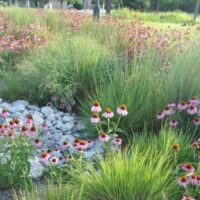
“The University of Illinois not only has relevant research and data across many departments, but also real-world examples of successful green infrastructure, along with other extension and education tools, such as the Red Oak Rain Garden,” said C. Eliana Brown, University of Illinois Extension stormwater specialist. “This new tool brings these resources together, providing a robust platform to access green infrastructure knowledge.”
For full article and videos please visit Illinois Groundwork provides a rich supply of green infrastructure resources – IISG
About IISG: These are trying times for the environment. Climate change and other concerns such as population growth, aquatic invasive species, contaminated waters, and loss of natural habitat, the southern Lake Michigan region faces many challenges. Illinois-Indiana Sea Grant (IISG), with its unique mandate to bring the latest science to those who can best use the information, serves a critical role in empowering people to solve problems in sustainable ways. The program is funded through National Oceanic and Atmospheric Administration (NOAA), the University of Illinois and Purdue University, but IISG also works in partnerships with key organizations, institutions, and agencies in the region to reach more audiences and multiply opportunities for success. IISG brings together scientists, educators, policy makers, community decision makers, outreach specialists, business leaders, and the general public to work towards a healthy environment and economy.
Resources
Center For Great Lakes Literacy (CGLL), Website
Ask An Expert: Hot and Cold, Video, Purdue Extension – Forestry and Natural Resources YouTube channel
Informing the Development of the Great Lakes Region Decision Support System, The Education Store, Purdue Extension’s resource center
Urban Best Management & Low Impact Development Practices, The Education Store
Improving Water Quality Around Your Farm, The Education Store
New website: Eat Midwest Fish, Got Nature? Blog, Purdue Extension – Forestry and Natural Resources (FNR)
Scientists bring the Great Lakes to students learning from home, Got Nature? Blog
Adaptations for Aquatic Amphibians Activity 2: Water Quality Sneak Peak, Purdue Nature of Teaching
Illinois-Indiana Sea Grant (IISG)
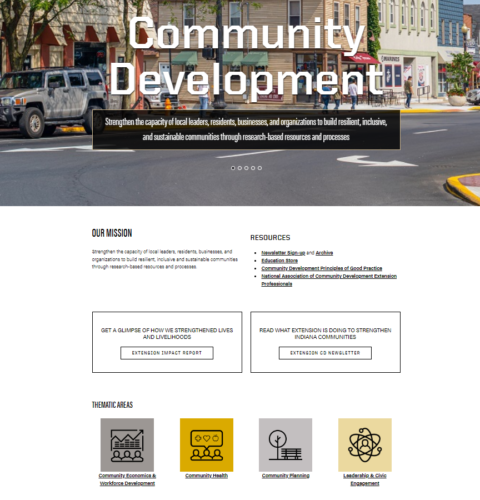 Question: What resources does Purdue Extension have on wind energy/contracts?
Question: What resources does Purdue Extension have on wind energy/contracts?
Answer: Purdue Extension has wind energy resources and information through the Purdue Extension – Community Development program. This program strengthens the capacity of local leaders, residents, businesses, and organizations to build resilient, inclusive and sustainable communities through research-based resources and processes. The team actively partners with a variety of state-level entities, including state agencies, private and nonprofit organizations, as well as universities and colleges. Such partnerships have facilitated the launch of applied research projects, the development of innovative educational programs and the delivering of technical assistance and non-formal education programs that are designed to meet the unique needs of Indiana communities and regions.
Under “Community Planning” you will find the resources and information for Renewable Energy. Learn more about the Purdue Extension Land Use Team as you visit the overview and find contacts, events, publications, general renewable energy, solar and wind resources.
Here are just a few of the resources listed on the Community Development-Community Planning-Wind Energy web page:
Agricultural Impact Statements: Wind Farms – State of Wisconsin Department of Agriculture, Trade and Consumer Protection
This article provides construction recommendations for commercial scale wind farms on farmland located specifically in the state of Wisconsin. This resource has links to licenses, permits, impact statements and groundwater quality reports that all pertain to the impacts of wind turbines on green-fields and the surrounding areas.
An Examination of the Community Level Dynamics Related to the Introduction of Wind Energy in Indiana
A team of researchers from Purdue University focused on where wind farm projects have and have not been located and examined socio-economic conditions that have resulted since the wind farms were (or were not) installed and made operational.
Blowing in the Wind: The Answer to Farmland Preservation – University of Michigan
This resource highlights the ways commercial wind farms can be used to preserve farmland and farming communities. This resource also emphasizes that wind farms are another source of income for farmers without having to sell their land.
Does my Land Qualify for a Wind Lease, LandGate Resources
This article highlights the requirements of a proper site for a commercial wind farm. These requirements include acreage, power grid access and the quality of the land. Included is a wind land estimator, designed to provide a rough estimate of a possible wind lease.
Sample Zoning for Wind Energy Systems – Michigan State University Extension
This publication presents a zoning ordinance sample amendment for utility-scale wind energy systems and smaller wind electric generation systems for an individual business or home.
These resources are just a glimpse from the Community Development program which shares many aspects of wind energy, along with other community planning, community economics and workforce development, community health, leadership and civic engagement. If you have further questions, feel free to reach out to the Renewable Energy Team.
Other Resources:
Environmental Planning in Community Plans, The Education Store, Purdue Extension’s resource center
Enhancing the Value of Public Spaces: Creating Healthy Communities, The Education Store
Conservation through Community Leadership, The Education Store
Tree Installation: Process and Practices, The Education Store
Planting Forest Trees and Shrubs in Indiana, The Education Store
Planting Your Tree Part 1: Choosing Your Tree, Video, Purdue Extension – Forestry and Natural Resources YouTube Channel
Tipping Point Planner
Sustainable Communities Extension Program
Subscribe – Purdue Extension – Forestry and Natural Resources YouTube Channel
Purdue Extension-Forestry and Natural Resources Calendar, workshops and Conferences
Michael Wilcox, Program Leader
Purdue Extension Community Development
Kara Salazar, Assistant Program Leader for Community Development and Sustainable Communities Extension Specialist
Purdue Forestry and Natural Resources/Illinois-Indiana Sea Grant/Purdue Extension
Diana Evans, Extension and Web Communication Specialist
Purdue University Department of Forestry and Natural Resources
Kara Salazar has been promoted to Assistant Program Leader for Purdue Extension Community Development. She has served in this role part-time but will now be fully dedicated to this program area. Kara will maintain her 25% appointment with Illinois-Indiana Sea Grant (IISG) and serve on the Agriculture Natural Resources (ANR) Extension Advisory Committee. She will still be located in the Forestry Building (FORS 308) and affiliated with the Department of Forestry and Natural Resources (FNR).
Working with multidisciplinary teams, Kara oversees the development and delivery of programs to support environmental planning, community development, and sustainable development strategies in communities across Indiana and the Great Lakes states. Kara provides leadership to the Purdue Extension Community Development Program and serves as a liaison between Illinois-Indiana Sea Grant and Purdue Extension.
Kara has a B.S. in public affairs and environmental science and a M.P.A. in natural resources management and nonprofit management from the Indiana University School of Public and Environmental Affairs. She also received a M.S. Ed . degree from the IU School of Education at Indiana University-Purdue University Indianapolis (IUPUI) with concentrations in community building and science education. Additionally, she is a Ph.D. candidate in Natural Resources Social Science at Purdue University. Kara is a member of the American Institute of Certified Planners (AICP), a Climate Change Professional (CC-P), and a Professional Community and Economic Developer (PCED) with credentials from LEED AP Neighborhood Development, the National Green Infrastructure Certification Program (NGICP), and the National Charrette institute.
Congratulations to Kara in her new position as she continues to move Purdue Extension and IISG forward with her expertise and team building.
Check out Kara’s lead role in the following programs and learn about the vast resources available:
Purdue Extension Community Development – strengthens the capacity of local leaders, residents, businesses, and organizations to build resilient, inclusive and sustainable communities through research-based resources and processes. Examples of a few of the programs and resources available include: Leadership and Civic Engagement, Community and Organizational Planning, Economic and Business Development.
Illinois-Indiana Sea Grant (IISG) – utilizes research, outreach, and education to bring the latest science to Great Lakes communities and their residents. By connecting decision-makers with science, we help strengthen and preserve ecosystems and communities in southern Lake Michigan and beyond.
Agriculture & Natural Resources (ANR), Purdue Extension – ANR Educators serve as research based, unbiased information source for county and state constituents on a variety of topics including: crops, ag business, livestock, natural resource, horticulture, small farms, urban ag, pesticide use, and land conservation.
Purdue Extension – a leader in providing relevant, high-impact educational programs that transform he lives and livelihoods of individuals and communities in Indiana and the world. Purdue Extension – Forestry & Natural Resources (FNR) is a branch of the Cooperative Extension Service/Purdue Extension. FNR Extension provides resources for aquaculture, fish management, urban and forestry management, natural re source planning, wildlife, and sustainable biomaterials. We encourage you to browse, download free publications, utilize our Ask an Expert, subscribe to Got Nature? newsletter and view upcoming workshops.
Sustainable Communities Extension Program (SCEP) – provides multidisciplinary teams focusing in the following areas: Placemaking and Enhancing the Value of Public Spaces; Land use Planning Education; Green Infra structure; Community Development; American Citizen Planner; Facilitation and Strategic Planning; Conservation Through Community Leadership; Rainscaping Education and Tipping Point Planner.
More Resources including Kara’s publications and videos:
Implementation Examples of Smart Growth Strategies in Indiana, The Education Store, Purdue Extension’s resource center
Conservation Through Community Leadership, The Education Store
Climate Change and Sustainable Development, The Education Store
Climate Change: Are you preparing for it?, The Education Store
Tipping Point Planner, The Education Store
Enhancing the Value of Public Spaces, The Education Store
Enhancing the Value of Public Spaces: Creating Healthy Communities, The Education Store
One Water Approach to Water Resources Management, The Education Store
Rainscaping Education Program, Purdue Extension
Conservation Through Community Leadership, Sustainable Communities Extension Program (SCEP)
Community Planning Playlist, Purdue Extension-Forestry & Natural Resources (FNR) YouTube Channel
Rainscaping and Rain Gardens, Purdue Extension YouTube Channel
Conservation through Community Leadership, Purdue Extension You Tube Channel
Enhancing the Value of Public Spaces Program, Purdue Extension YouTube Channel
Tipping Point Planner, Purdue Agriculture YouTube Channel
Indiana Creek Watershed Project – Keys to Success, Partnerships and People, Purdue Extension You Tube Channel
Subscribe to Purdue Extension – Forestry and Natural Resources YouTube Channel
Diana Evans, Extension and Web Communication Specialist
Purdue University Department of Forestry and Natural Resources
The new USDA-Natural Resources Conservation Service (NRCS) website is designed for farmers, ranchers and forest landowners who use NRCS conservation programs, and our partners who help us deliver the conservation mission.
You will find information that includes:
- Conservation Basics: find soil health, soil science, water, air, plants, animals, land, energy, climate, wildlife habitat and invasive species and pests
- Getting Assistance: find your local service center
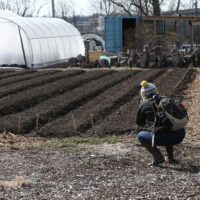
- Programs & Initiatives
- Resources
- News & Events
For more than 80 years, NRCS has helped people make investments in their operations and local communities to keep working lands working, boost rural economies, increase the competitiveness of American agriculture, and improve the quality of our air, water, soil, and habitat.
As the USDA’s primary private lands conservation agency, NRCS generates, manages, shares data, technology and standards that enable partners and policymakers to make decisions informed by objective, reliable science.
Resources:
Consumer Horticulture: Collecting Soil Samples for Testing, The Education Store , Purdue Extension resource center
Soil Sampling Guidelines, The Education Store
Soil Testing for Lawns, The Education Store
Certified Soil Testing Laboratories, Purdue Extension – Master Gardener Program
Lawn to Lake Midwest, Illinois-Indiana Sea Grant Program
Forest Improvement Handbook, The Education Store
Frost Seeding Native Grasses and Forbs with a Drone (UAV), Purdue Extension-Forestry & Natural Resources (FNR)
Hardwood Ecosystem Experiment – Wildlife Responses to Timber Harvesting, The Education Store
Invasive Plants: Impact on Environment and People, The Education Store
Sustainable Communities, Purdue Extension
Urban Forestry, Playlist, Purdue Extension – FNR YouTube Channel
USDA-Natural Resources Conservation Service (NRCS)
Lawn to Lake Midwest is a great resource as the experts share each month care tips on how to have a healthy lawn all year long while using natural lawn care practices. For the month of May check out the things to watch out for and why testing your soil is important.
You will also find resources for more options for a sustainable lawn:
- Take the Natural Lawn Care Quiz and see where you are at with your lawn care practices.
- Take a look at some simply ways to incorporate more natural lawn care practices.
- If you’re ready, jump into the weeds to explore even more sustainable lawn management practices.
- Find answers to commonly asked lawn care questions.
Resources:
Forest Improvement Handbook, The Education Store
Turfgrass Science, Department of Horticulture & Landscape Architecture
Turfgrass Insect Management, The Education Store
Tree Planting Part 1: Choosing a Tree, Video, The Education Store
Purdue Turf Doctor app for Apple iOS, Apple App Store
Illinois-Indiana Sea Grant (IISG)
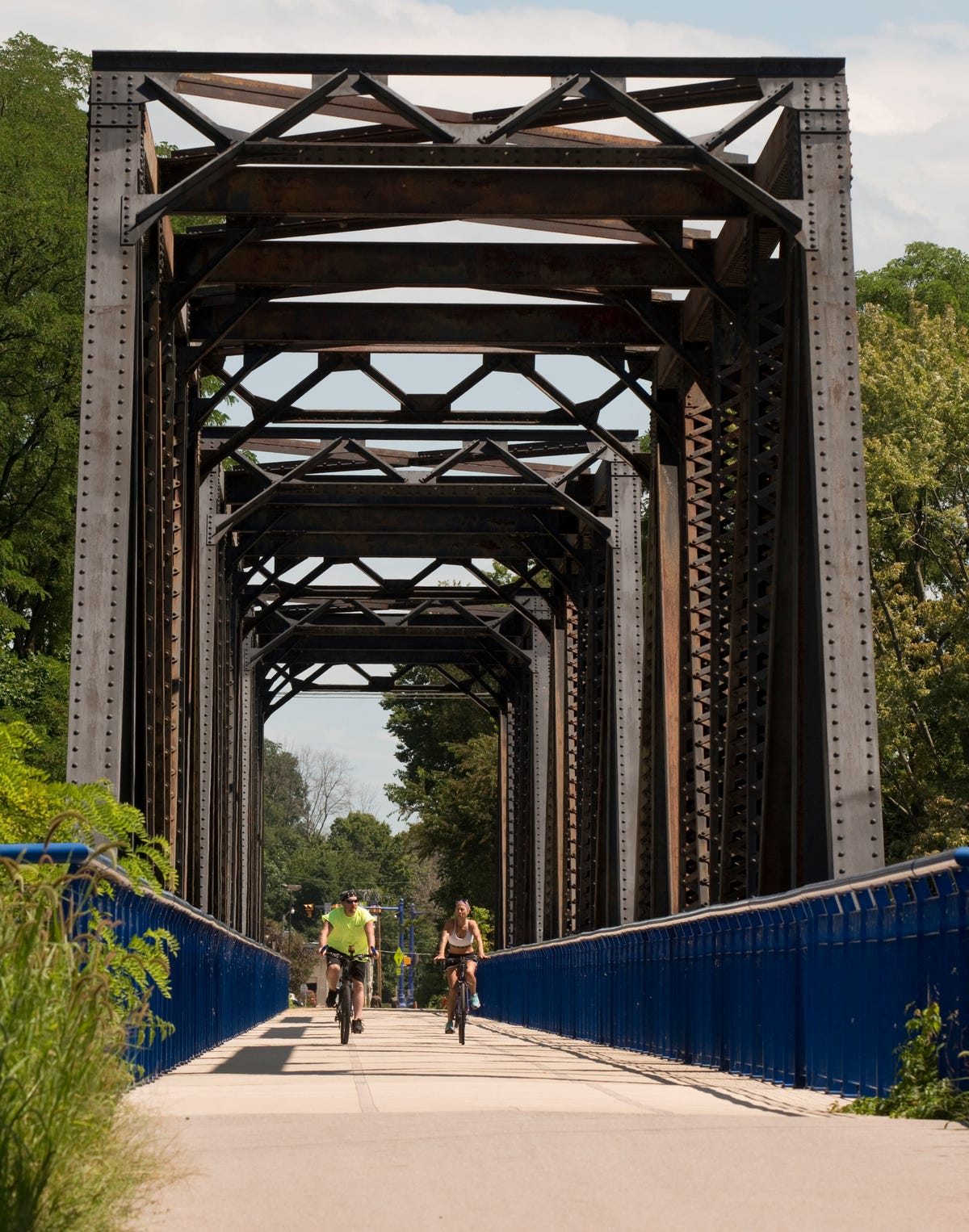 MyDNR Newsletter, Indiana Department of Forestry and Natural Resources: Gov. Eric J. Holcomb and DNR Director Dan Bortner recently announced 38 communities and non-profit organizations will receive a combined $65 million for 77 miles of new trail development.
MyDNR Newsletter, Indiana Department of Forestry and Natural Resources: Gov. Eric J. Holcomb and DNR Director Dan Bortner recently announced 38 communities and non-profit organizations will receive a combined $65 million for 77 miles of new trail development.
“Trails connect communities together in such a personal way and are perfect pathways to good mental and physical well-being,” Gov. Holcomb said.
A $150 million grant program, Next Level Trails is the largest infusion of trails funding in state history. In rounds one and two, a total of $55 million was awarded to 35 communities. To date, $120 million has been awarded to build 190 miles of trails throughout Indiana. Ninety-four percent of Hoosiers live within five miles of a trail.
The grants awarded in the third round include 17 regional projects and 21 local projects. The list of awards, project descriptions, and a map are posted at on.IN.gov/NLT-round-3.
To read other news articles visit Indiana Department of forestry and Natural Resources website.
Resources:
Enhancing The Value of Public Spaces, Purdue Extension Forestry and Natural Resources
Enhancing The Value of Public Spaces: Creating Healthy Communities, The Education Store, Purdue Extension’s resource center
Fun Trail Event Days, Indiana Department of Natural Resources
Healthy and Wellness Videos, The Nature of Teaching YouTube Channel
Benefits of Connecting with Nature, The Education Store
Indiana Department of Natural Resources
Frost seeding is a great way to establish native grasses and forbs for soil and water conservation and to create habitat for various wildlife and pollinators. You can use multiple tools for frost seeding, such as a tractor or ATV and broadcast spreader or a hand “whirlybird” seed spreader. But one innovative way to broadcast the seed is with a drone – or Unmanned Aerial Vehicle (UAV).
A drone is the tool we used to frost seed native grasses and forbs as part of a project on the Ivy Tech Community College-Lafayette Campus.
The Project
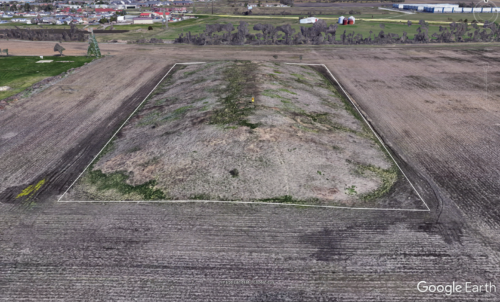 Faculty and staff within the Agriculture Program at Ivy Tech Community College received a grant from the Wabash River Enhancement Corporation (WREC) to plant native grasses and forbs on their property for educational and demonstration opportunities.
Faculty and staff within the Agriculture Program at Ivy Tech Community College received a grant from the Wabash River Enhancement Corporation (WREC) to plant native grasses and forbs on their property for educational and demonstration opportunities.
We planted a 4-acre mound created from soil leftover after digging a nearby retention pond. The topography and slopes of the mound made using traditional planting equipment like a tractor and no-till drill a challenge. And since the Ivy Tech staff was already familiar with using drones to plant cover crops, they decided it would be the best option to seed the mound.
The Indiana Natural Resources Conservation Service State Biologist created the seed mix we used. The mix included a diverse blend of native warm-season grasses and forbs.
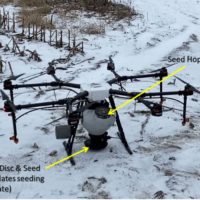 Purdue Extension and Purdue Forestry and Natural Resources assisted in the project by supplying, calibrating, and flying the drone, sharing previous experiences with frost seeding native grasses and forbs, and adjusting the seed mix by adding a carrier to improve seed flow through the drone seed spreader.
Purdue Extension and Purdue Forestry and Natural Resources assisted in the project by supplying, calibrating, and flying the drone, sharing previous experiences with frost seeding native grasses and forbs, and adjusting the seed mix by adding a carrier to improve seed flow through the drone seed spreader.
The Drone Set-up
We used a DJI Agras MG-1P drone fitted with a seed hopper that could be filled with up to 22 pounds of seed. Once filled, the drone spreads the seed at a specific rate (pounds per acre) by flying a consistent speed and height across the field along a predetermined path. A hand-held controller allows you to change the drone’s flight path, speed, and height. The controller also allows you to turn the broadcast spreader on or off, adjust the seed gate opening (% open), and the revolutions/minute of the disc to change the rate of the spreader.
The Process
Mixing the seed
The first step was to ensure the seed would flow through the seed hopper. This drone is set up to spread cover crops, which are usually large, heavy seeds like cereal rye or smaller (but still relatively heavy) seeds like clovers.
Native grasses and forbs are often much smaller and lower in weight by volume than cover crops. The grasses are also “fluffy” or have extra seed parts (chaff or awns), making them prone to clogging. These qualities of native grasses and forbs can present a challenge when trying to broadcast them without specialized equipment. We often add a carrier, like pelletized lime, to add more weight to the seed mix and allow the seed to flow more easily through the spreader. We added 40 pounds of pelletized lime per acre to the seed mix.
Calibrating the drone
We needed to calibrate the drone to spread the right amount of seed per acre. Calibrating a drone is similar to calibrating any broadcasting equipment. We needed to know:
- How wide the spreader spreads the seed (swath width)
- How fast the drone is flying
- How much seed (lbs) is being spread over a specific area
Check out this video for more information about frost seeding and calibrating a broadcast spreader.
Creating the map and programming the drone
After finishing the calibration, we went to the field to create the map for the project and program the drone. The initial step with the drone is to create a boundary layer in the mapping software. We did this by physically taking the controller to the four corners of the mound and setting a GPS point. When the accuracy showed 5 feet or less, we dropped a pin and used that as a corner. Once the corners were marked, the mapping software created the boundaries of the mound and created an automated path for the drone to fly.
Once we completed the map, we filled the drone with seed and set the flight parameters. Our calibration figures showed that we needed a 90% hopper opening with a speed of 2 mph, and we had a swath width of 18 feet from 10 feet above the ground (drone height). The disc speed was set to 900 revolutions per minute.
Spreading the Seed
Once the seed was mixed and the drone was calibrated and programmed, we started spreading the seed. With the drone, this is as easy as filling the seed hopper, starting the drone, and allowing it to fly the planned and automated mission. Once the seed hopper is empty, the drone automatically remembers where it stopped and returns home to be refilled. Once refilled, the drone will return to where it stopped and restarts spreading the seed. This process repeats until the drone has covered the entire field.
The Challenges
Fluffy seeds and seed flow
One of the biggest challenges we encountered was the flow of the native grass seed through the seed hopper. The seed was too fluffy (not enough weight per volume) to flow correctly through the seed hopper. The seed would flow and spread correctly for a few minutes, then the seed would get clogged, and the drone would stop. Because the fluffy seed was getting stuck at the top of the hopper and not flowing correctly, the sensor on the drone’s seed hopper was telling us the seed hopper was empty. However, at least 5-10 pounds of seed was still in the hopper. This would cause the drone to fly back to be refilled. Each time this happened, it cost us time and battery life on the drone.
We were able to free the seed in the hopper and get it to flow correctly by rocking the drone or flying the drone back and forth quickly until the seed worked itself loose. If you were using traditional equipment like a tractor and fertilizer spreader, the bouncing of the tractor over rough terrain would have naturally agitated the seed and allowed it to flow. But, with a drone flying in the air, the seed was not agitated. We would have needed to add more carrier to the seed mix to increase its weight and improve the seed flow.
Broadcast spreaders designed to spread fluffy seeds like native grasses often have an agitator in the hopper to stop the seed from clogging and improve seed flow. The native grass seed would have flowed better through a drone seed spreader explicitly designed for this type of seed, like this aerial spreader.
Batteries and Battery Life
Some of the challenges with drones, in general, are batteries and battery life. We had to change batteries frequently while spreading and recharge the batteries not in use to ensure we had enough battery life to complete the seeding. The challenges we had with the seed flow exacerbated our challenges with batteries because each time we had to check the seed hopper or free the seed, it cost us battery life.
It was helpful that we had six batteries. This allowed us to rotate between using batteries and charging them and meant we didn’t have to stop spreading to wait on batteries to be charged.
Flight speed
Because we added extra weight to the seed mix by using a carrier, we needed to fly the drone at a slow speed to spread at the correct rate per acre. Keeping the drone at a lower speed (2 mph) was challenging. Often the drone flew at around 3 mph. This is likely due to the physical properties of the electric motors turning the propellers to keep the drone aloft.
Drone malfunction
Another challenge we faced was a malfunction on the UAV where the spreader gate was opening and closing on its own, or not opening at all, and had an error showing on the controller screen that the gate was blocked. We noticed this error and worked on the UAV during the calibration phase and thought it was repaired. We had to stop and take the spreader apart again to identify the problem.
On the day we seeded, we finally decided to open the hopper to 90% opening and physically stop the gears from opening and closing. This left the hopper open constantly, but we could still turn the spreader on and off. After finishing the seeding, we determined the issue was either a faulty servo motor or control board. These parts are inexpensive and can be replaced, but they are specialized parts that require ordering and cannot be picked up from a local hardware store.
Cost of the drone
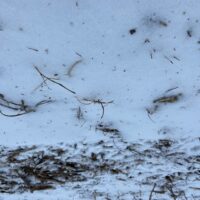 The DJI Agras MG-1P is an older model (older, not outdated), so the cost has decreased. Initially this model cost around $19,000, but it is now about $8,000. This includes both attachments for spraying and spreading. Additional batteries are around $700 each. Cost for the newer models of this type of drone range from $18,000 to ~$30,000, depending on the size and payload.
The DJI Agras MG-1P is an older model (older, not outdated), so the cost has decreased. Initially this model cost around $19,000, but it is now about $8,000. This includes both attachments for spraying and spreading. Additional batteries are around $700 each. Cost for the newer models of this type of drone range from $18,000 to ~$30,000, depending on the size and payload.
The Results
Despite the challenges we faced, the drone worked well for spreading the native grass and forb seed for this project. We applied the correct amount of seed required for the area. When the seed flowed correctly, it was spread evenly on the site. However, we will need to come back to the site during the next few summers to see how well native grasses and forbs are established.
A drone may not be effective for large-scale conservation plantings because of the time and batteries required, the small hopper size, and the need to refill the seed hopper. But for smaller plantings or those plantings in areas inaccessible by traditional equipment (in wetlands, on steep slopes, woodlands, etc.), drones could be an effective tool to establish native grasses and forbs.
Resources:
Frost Seeding to Establish Wildlife Food Plots & Native Grass and Forb Plantings, video, The Education Store, Purdue Extension Resource Center
Calibrating a No-Till Drill for Conservation Plantings and Wildlife Food Plots, video, The Education Store
Renovating native warm-season grass stands for wildlife: a land manager’s guide, The Education Store
Creating a Wildlife Habitat Management Plan for Landowners, The Education Store
Purdue Extension Pond and Wildlife Management Website, Purdue Extension
Jarred Brooke, Wildlife Extension Specialist
Purdue Forestry and Natural Resources
John Scott, Purdue Extension Coordinator of Digital Agriculture
College of Agriculture
Recent Posts
- New Deer Impact Toolbox
Posted: April 7, 2024 in Forestry, Land Use, Plants, Publication, Safety, Wildlife, Woodlands - Natural Resources Commission Updates – Wild Bulletin
Posted: March 4, 2024 in Forestry, How To, Land Use, Natural Resource Planning, Plants, Wildlife, Woodlands - Barn Owls in Goose Pond Fish & Wildlife Area Nest Box, MyDNR
Posted: in Forestry, Land Use, Safety, Wildlife, Woodlands - Habitat University Podcast – Private Lands Wrapped
Posted: February 9, 2024 in Forestry, Land Use, Podcasts, Wildlife, Woodlands - Toms, Tines, and Tanagers: Forest Management for Game Species Webinar
Posted: in Forestry, Land Use, Webinar, Wildlife, Woodlands - Nature of Teaching, Connecting Youth With Nature for Health and Education – ANR
Posted: February 6, 2024 in Forestry, How To, Land Use, Nature of Teaching, Plants, Wildlife, Woodlands - Purdue Extension 2023 Impact Report
Posted: in Forestry, Land Use, Plants, Publication, Wildlife, Woodlands - Build a Better Habitat for Wildlife This Winter – Wild Bulletin
Posted: February 1, 2024 in Forestry, How To, Land Use, Natural Resource Planning, Plants, Wildlife, Woodlands - Updated Indiana Woodland Steward Newsletter
Posted: January 20, 2024 in Community Development, Forestry, Forests and Street Trees, Land Use, Wildlife, Woodlands - Hardwood Tree Improvement Regeneration Center (HTIRC) Shares Fall Newsletter, Research and Outreach
Posted: December 13, 2023 in Forestry, Land Use, Natural Resource Planning, Woodlands
Archives
Categories
- Alert
- Aquaculture/Fish
- Aquatic/Aquaculture Resources
- Ask the Expert
- Christmas Trees
- Community Development
- Disease
- Drought
- Forestry
- Forests and Street Trees
- Gardening
- Got Nature for Kids
- Great Lakes
- How To
- Invasive Animal Species
- Invasive Insects
- Invasive Plant Species
- Land Use
- Natural Resource Planning
- Nature of Teaching
- Plants
- Podcasts
- Ponds
- Publication
- Safety
- Timber Marketing
- Uncategorized
- Urban Forestry
- Webinar
- Wildlife
- Wood Products/Manufacturing
- Woodland Management Moment
- Woodlands
